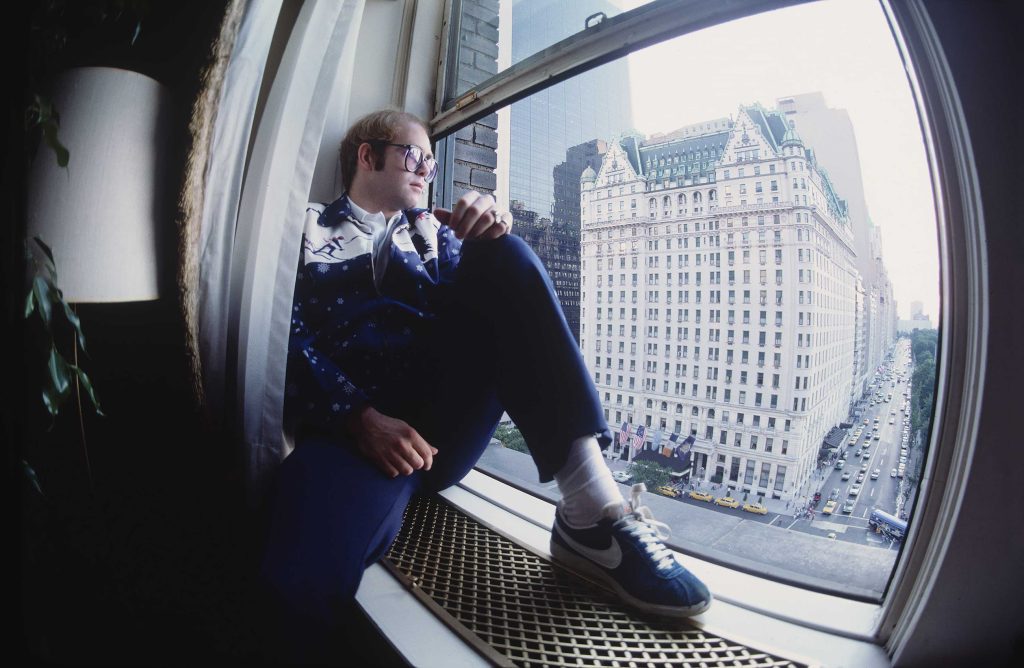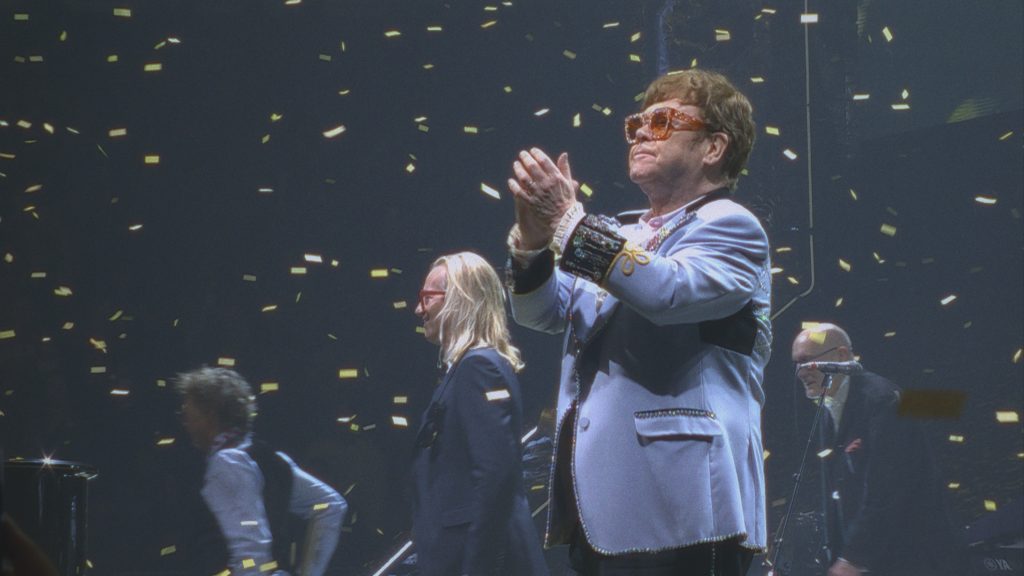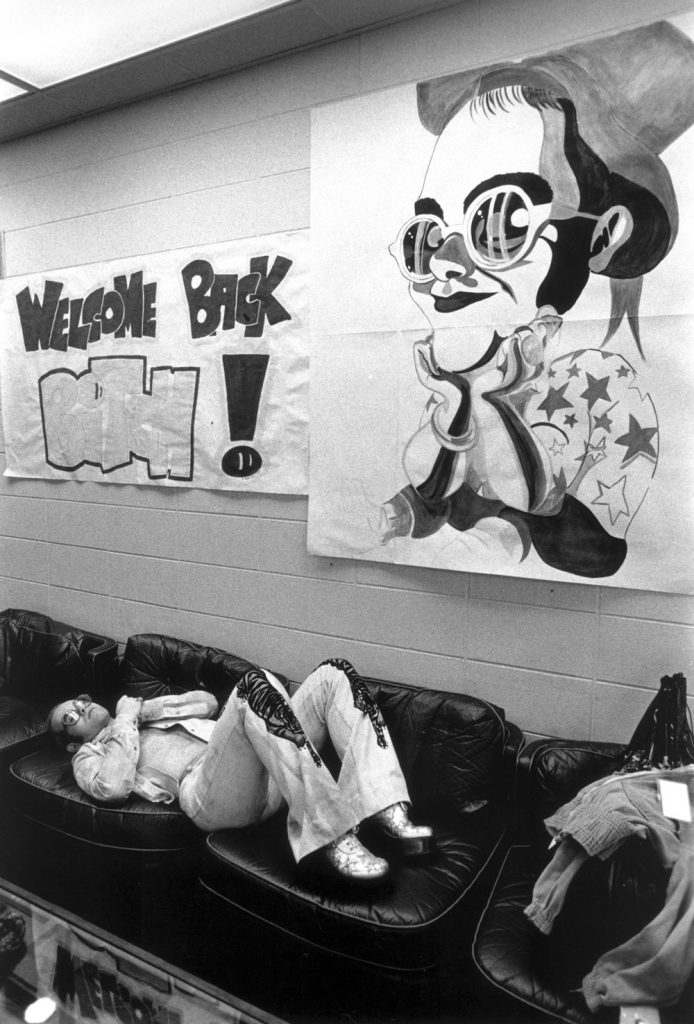Menu
‘Never Too Late’…More From the Archive Producers
This is Part 2 of a conversation between EltonJohn.com’s John F. Higgins and Kate and Mike Griffiths, the Archive Producers for Elton John: Never Too Late, available to stream on Disney+. John worked on the documentary with the Griffiths as Elton John’s Legacy Consultant. (Part 1 can be found here.)

Elton in NYC, 1976 - Photo: Ron Pownall
EltonJohn.com: Did you get any feedback from Elton on a particular archival piece you found?
Mike Griffiths: When he first watched an early cut we did hear back that he was blown away by the amount of stuff he hadn’t seen before. With a career as long as Elton’s, you can’t remember everything. We were really happy to remind him of things…or show him things for the first time.
EJ.com: It must be difficult, if not impossible, to get everything you found into the final cut.
Kate Griffiths: The thing is, we had 90 minutes to tell this story. And Elton’s story is so rich that you could tell just one year of his life in 90 minutes! Sometimes you introduce a piece of archive, but the lead into it is such that it just takes up too much time in that story, and you’ve got to move on.
MG: We did find some lovely Pinner footage, actually, from the period. One of them was made by the Pinner Film Society [now called Harrow Film Makers]. One of their films opens with the ideal shot of Pinner High Street with the church at the end of it and a series of 1950s motor cars coming down the street, and…a massive caption over it that says “Pinner Film Society”! Which is a real shame because it’s lovely, lovely footage.
EJ.com: Did you go through the Pinner footage trying to find a young Reg Dwight out and about?
MG: Yeah I was always doing that! There is home movie footage – some of it on YouTube, actually – of the annual Pinner Fair in the ‘50s. And I watched every child on that roundabout, every child walking through the fair. Going, “Can I spot him?”[laughing].
EJ.com: And then there are the holy grails…
KG: Yes. We were hoping to find more from the Troubadour. There is no way that only two minutes of that footage was shot. We hope that the parties that we believe have it hopefully, one day, will be persuaded. We absolutely tried. I mean, this is the thing, finding an archive is really just the first piece of the puzzle. You may know it’s there, but actually getting the gatekeeper, opening that lock, having your hands on it, and then being able to use it…because you’ve got some clearances, you’ve got copyrights…that is another thing entirely.
EJ.com: Is rights clearances an art or a science?
MG: I think both! Kate handles the Rights negotiations with archives and whilst there are set parameters around license fees and other underlying 3rd party rights, (the science!) there is an art to negotiation. Being trustworthy, knowing the marketplace, and having great relationships goes a long way to getting the best deals, and Kate is very good at that!
KG: We did have a lot more archive in the final film that was budgeted for. For this 90-minute film they wanted modern-day footage, animation, live performances, and archives. So it was going to be like a four-quarters thing. But it’s now two-thirds of archive. And from over 80 different sources! This was a once-in-a-lifetime project for us. I mean, we rarely get to work on such a project that’s got such good will and such support. Everyone we dealt with were like, “We love Elton!”
MG: So many of the European archives’ staffers were like, “Oh, I’m going to the concert tomorrow night!”
KG We are very happy to talk about this because it is quite a hidden thing: archive research. People don’t fully understand what goes on. It isn’t all owned by Elton, though some obviously was. For example, at the beginning of the project we did a sweep worldwide where we emailed over 150 different sources that we knew about – major sources. And, particularly the news archives in America, they hadn’t digitized stuff. At the end of the documentary, where he’s getting his star on the Hollywood Walk of Fame, and you’ve got aerial shots and everything? That came from four or five different news agencies. But they hadn’t transferred a lot of that stuff so we had to get that scanned. And they were alerting me throughout the process, “Hey, we’ve just found some more stuff!”
MG: We were really hoping to find footage of Elton (well, Reg) when he’s playing keyboards for all those American touring artists like Patti LaBelle. Maybe that is out there somewhere, but you can only pursue some of this stuff for so long before you’ve got to move on to something else. We had to get to 1970 as soon as we could so we didn’t really go into Bluesology more than briefly: we had a fantastic man, Nick Warburton, who’d scanned all of the Bluesology gig notices. And then of course there were the finds like the front covers of the recording tape boxes. To me that’s real ephemera, with the handwriting and the crossing off.
EJ.com: If you close your eyes you would think it was Elton playing. And then how they used it in the film where they married it with Little Richard and Jerry Lee Lewis footage. It’s fantastic to see it all coalesced into a few seconds, visually.
KG: We had to go through lots of different clips to find the right ones where they were standing in the right position and how editorially it all fitted in. I mean, it is an artistry. We can’t understate the editor’s role in all of this, and [the editors] Greg Finton and Poppy [Das] were just such a tour de force.

Farewell Yellow Brick Road - Madison Sq. Garden (Photo courtesy of This Machine)
MG: I think as well that with these kind of films the director has a vision but the editor kind of puts it all together. It’s a storytelling process but I often think that it’s the editor who’s initially telling the story. The director’s kind of going. “Okay, can we can we kind of do this this and this?” And the editor does that as well. I think the role of the editor sometimes is very underestimated.
KG: We weren’t in the edit at all because we weren’t over there [in Los Angeles] but I do know that David and R.J. were both very present so they were absolutely you know the final decision-makers on every single shot in that film. What made it and what didn’t was their decision. And they weren’t interested in the big known pieces. I mean, yes, there’s some obviously classic footage in there, but everyone’s seen the Cher show or the Muppets Show or the Top of the Pops.
EJ.com: I was expecting a little bit more of the Watford ‘74 concert footage in the final documentary.
KG: .That concert wasn’t filmed for public consumption. It was actually just for a live projection – for when you’re at the show. But Elton wanted to have his own version of the recording, so they did a copy onto an old Philips tape – a very early VHS. We found it labeled in Elton’s archives; nobody knew what it was. We pulled out a number of tapes and assets that hadn’t been labeled – that were unknowns – so we found some really interesting things that were totally random and not relevant but all part of Elton’s story. And with it was the last 30 minutes of the Watford concert. That’s what you see a snippet of: him jumping up on the piano.
EJ.com: One of the things I hoped we could have found was where Elton and Bernie appear on screen when Lulu
sings I Can’t Go On Living Without You on her show for the Eurovision Song Contest.
KG: You and I worked quite diligently on that, didn’t we? And Mike. She sang it twice…on two different episodes. So, the one where the announcer is going “[written] by Elton John and Bernie Paupin”. We have that. But there were various different sources saying, “I remember seeing Elton and Bernie on the screen.” We literally did email every other European channel that would have carried Song For Europe (as it was known at that time) saying, “Have you got this?” And everyone said no. We actually contacted Lula and her archivist as well and they were as helpful as they could be and looked through, but they didn’t have it either. That’s one of those things that will surface one day. You know, we’ll be looking for something else and…
EJ.com: For people that aren’t super-familiar with Elton’s story, what would you like their takeaway from the film to be?
KG: I mean the big one for us is, Elton needed saving. He needed saving from himself and he needed something to grab on to. A life raft to take him away from the drugs and the drink and the abusive relationships or whatever you want to call it. And I think his friendship with Billie Jean King is something that hasn’t really been talked about. Elton has saved people; he’s reached out to Robbie [Williams] and others…but he needed saving and I think Billie Jean and sport have been a huge part of that. He talks about [former Watford FC Manager] Graham Taylor as being a huge, huge influence to him…and father figure. Obviously now you’ve got Ryan Reynolds and Wrexham and that kind of fascination, but Elton did it 30-40 years before, with Watford.

Elton backstage in 1974 (Photo: Sam Emerson)
EJ.com: So, you took a crash course in Eltonology. You went from being, I’m assuming, Elton fans – you know “normal” Elton fans…
KG: Oh yes. We’ve always loved the music!
EJ.com: …to being, in essence, Elton experts of that five-year-period. Did your perception of him change?
KG: Oh, so much more admiration for him! His philanthropy, his generosity, his kindness. I mean, to find out about all of his work with the EJAF and meeting Ryan White and deciding to launch the EJAF and the millions of pounds they’ve raised – the millions of people they’ve helped. He has a very generous soul.
MG: I also think one of the great insights for us as well was the music. I mean when we started the project I knew a lot of Elton John songs, like everyone. But there were a lot of album tracks that I didn’t know. I remember listening to [the Elton John album] through the first time we started the project and going, “Oh my god…this is remarkable!” They’re all remarkable, but those early albums were a real eye-opener for me. Funnily enough, this morning I was walking the dog and I’m forever singing Mona Lisas and Mad Hatters in my head! He’s in there forever now, you know?
